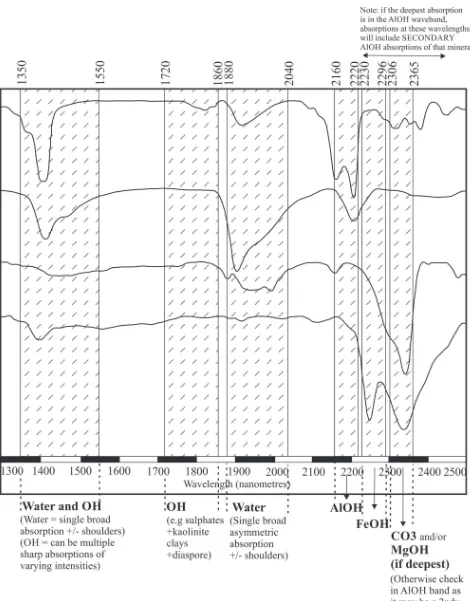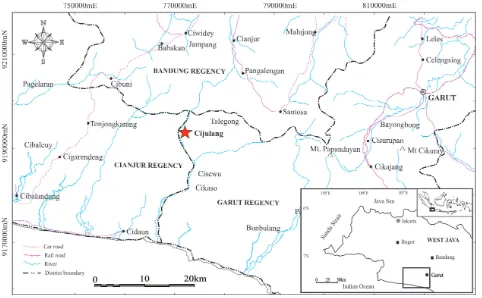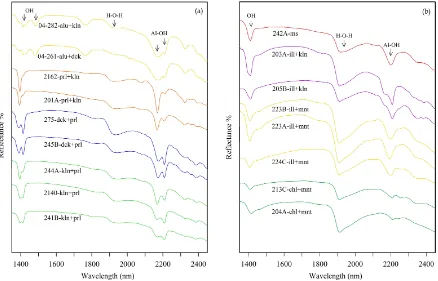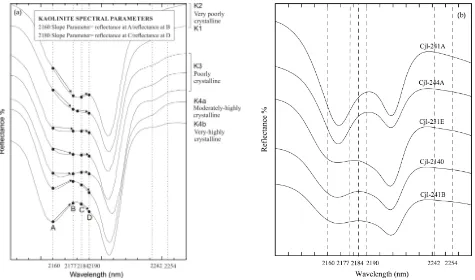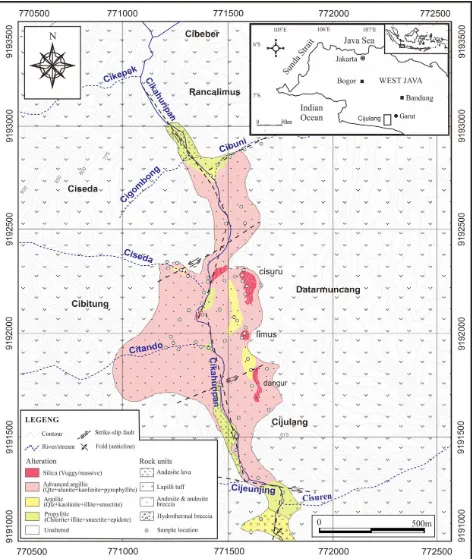CHARACTERISTICS OF HYDROTHERMAL
ALTERATION IN CIJULANG AREA, WEST JAVA,
INDONESIA
Myo Min Tun*1, I Wayan Warmada2, Arifudin Idrus2, Agung Harijoko2, Reza Al-Furqan3, and Koichiro Watanabe4
1Department of Geology, Mandalay University, Mandalay, Myanmar
2Geological Engineering Department, Faculty of Engineering, Gadjah Mada University, Yogyakarta, Indonesia 3PT. Eksplorasi Nusa Jaya/Freeport-McMoran Copper & Gold
4Department of Earth Resources Engineering, Faculty of Engineering, Kyushu University, 744 Motooka, Nishi-ku, Fukuoka 819-0395, Japan
Abstract
Characterization of hydrothermal alteration in the Cijulang area (West Java, Indonesia) was carried out using shortwave infrared spectroscopy. Hy-drothermal alteration in the Cijulang area occurs in the calc-alkaline volcanic and volcaniclastic rocks. Shortwave infrared spectroscopic measurements of reflectance for altered rocks and minerals were car-ried out by ASD-FieldSpec and the laboratory spec-tra acquired were then analysed with “The Spec-tral Geologist” software program. Shortwave in-frared spectroscopy is capable of detecting most fine-grained alteration minerals from different hydrother-mal alteration zones. Characteristic alteration min-erals identified from the SWIR technique include py-rophyllite, alunite, kaolinite, dickite, illite, montmo-rillonite, polygorskite, gypsum, epidote, paragonite, and muscovite. Most of the spectra show mixture of alteration minerals and only a few display pure spec-tra of single mineral. The crystallinity of kaolinite from the samples was also determined from the re-flectance spectra and show moderately to high crys-tallinity. Alteration system of the Cijulang prospect is similar to others documented high-sulfidation ep-ithermal deposits, such as Rodalquilar (Spain), Sum-mitville (Colorado), and Lepanto (Philippines). A characteristic alteration sequence and zonation of
*Corresponding author: M.M. TUN, Department of Geology, Mandalay University, Mandalay, Myanmar. E-mail: [email protected]
advanced argillic, argillic and propylitic alteration outward from the silica core has resulted from the progressive cooling and neutralization of hot acidic magmatic fluid with the host rocks.
Keywords: Cijulang, High-sulfidation, Alteration minerals, Shortwave Infrared Spectroscopy
1 Introduction
Shortwave infrared reflectance (SWIR) spec-troscopy has been widely used in hydrothermal alteration mapping of various types of min-eral deposits, such as high- and low-sulfidation epithermal, mesothermal, porphyry, sediment-hosted gold and copper, uranium, volcanogenic massive sulfide (VMS) and kimberlite. SWIR spectroscopy involves detection of the en-ergy generated by vibrations within molecular bonds in the 1300- to 2500-nm (SWIR) range of electromagnetic spectrum (Thompson et al., 1999). Most minerals exhibit characteristic spec-trum and major diagnostic absorption features in this SWIR region as a result of bending and stretching of certain molecules and radical, in-cluding OH, H2O, NH4, and Cation-OH bonds
TUNet al.
and diagnostic spectral absorption features re-lated to cation-OH bonds such as AlOH, FeOH and MgOH occur at or near 2200nm, 2250nm and 2330nm respectively (Figure 1). The ab-sorption features that represent these bonds or mineral groups are characteristic of hydrother-mal alteration and mineral groups belonging to kaolinite, halloysite, pyrophyllite, smectite clays, dickite, micas, chlorites, alunite, jarosite, calcite (Pontualet al., 1997).
Reflectance spectra can be acquired by field portable spectrometers, such as GER-IRIS, ASD-FieldSpec and PIMA or by airborne re-mote sensing. Application of spectrometers allows rapid identification of the fine-grained hydrothermal alteration minerals which are generally difficult to identify by conventional macroscopic observation. SWIR spectroscopy not only detects the presence of minerals in the sample but also determines the relative abun-dance of mineral within the samples. Moreover, mineralogical and compositional variation in certain specific mineral species can also be rec-ognized by the SWIR technique (Thompson et al., 1999).
Cijulang area is located in the Garut Re-gency of West Java, Indonesia (Figure 2) and the prospect has been explored by PT Aneka Tam-bang since 1994. This research aims to explore the characteristics of the hydrothermal alter-ation associated with pyrite-enargite-gold min-eralization in the Cijulang prospect by the ap-plication of reflectance spectroscopy.
2 Research methods
Field investigation was carried out in the Ciju-lang area of West Java, Indonesia during March, 2013. A total of 70 altered rock and clay sam-ples were collected from different hydrother-mal alteration zones. Study on alteration min-eralogy was carried out by Shortwave Infrared Spectroscopy (SWIR) aided by petrographic mi-croscopy, X-Ray Diffraction and SEM-EDS anal-yses.
Shortwave infrared (SWIR) spectroscopic measurement of reflectance for altered rocks and clay minerals was carried out by Analytical Spectral Devices (ASD-FieldSpec), a
spectro-radiometer which collected the reflectance in the 350 to 2500nm spectral range. The re-flectance spectra acquired by ASD device were then analyzed with “The Spectral Geologist™ (TSG)” software. The TSG provides automated assistance in the mineral identification and statistical analysis of the spectra. Mineral iden-tification was conducted by spectral matching with reference library spectra. The Spectral Assistant (TSA) in The Spectral Geologist uses a library of 551 spectra of pure minerals and water. The software identifies a maximum of three minerals assigning relative weights and an error of matching. The relative weight does not represent the abundance of minerals in the samples but it reflects the relative proportion of one mineral to another which is influenced by grain size and distribution of the minerals. The level of confidence in the mineral identification is indicated by the error of matching.
Interpretation of spectral data from TSG soft-ware were cross-checked by spectral interpre-tation field manual and USGS library spectra. Identification of the mineral is based on the fol-lowing spectral characteristics; wavelength po-sition, intensity and shape of the absorption troughs and the overall shape of the entire spec-trum. Shifting of the wavelength positions of diagnostic absorption feature represents com-positional variation in minerals whereas varia-tion in depth or width of the absorpvaria-tion feature reflects the variation in crystallinity or the grain size of the relative abundance of mineral (Pon-tualet al., 1997).
Bulk rock powdered and clay fraction sam-ples were analyzed by Rigaku RINT-2100 Diffractometer at Laboratory of Earth Resources Engineering Department, Faculty of Engineer-ing, Kyushu University. X-ray diffraction anal-ysis was done using CuKα radiation at 40kV
TUNet al.
Figure 2: Location map of Cijulang area, Garut Regency, West Java, Indonesia.
3 Results and Discussion
3.1 Alteration Minerals
Hydrothermal alteration minerals identified from reflectance spectra of altered rocks and clay minerals include kaolinite, dickite, py-rophyllite, illite, muscovite, chlorite, alunite, epidote, polygorskite, and goethite. Most of the spectra show a mixture of these alteration minerals and only a few show pure spec-tra of single minerals. The common mineral assemblages identified from the reflectance spectroscopy include pyrophyllite–kaolinite, dickite–pyrophyllite, alunite–dickite, alunite– kaolinite, kaolinite–illite, illite–montmorillonite and chlorite–montmorillonite (Figures 3a and 3b).
3.2 SWIR Spectral Characteristics of Alter-ation Minerals
Kandite group minerals
Kaolinite [Al2Si2O5(OH)4]. Kaolinite
gener-ally occurs as pure mineral spectra or mix
spec-tra with other mineral such as dickite, py-rophyllite and illite. Kaolinite spectra have the following major absorption features: hy-droxyl (OH) stretching doublet around 1400nm and 1411nm, water (H2O) absorption feature at
1913nm and Al-OH diagnostic double absorp-tion feature at 2168nm and 2208nm (Figure 3a).
Dickite [Al2Si2O5(OH)4]. Dickite is one of the
kandite group minerals commonly found in the Cijulang prospect. It occurs as pure mineral spectra or mix spectra with other minerals, such as pyrophyllite and kaolinite (Figure 3a). Spec-tral characteristics of dickite are similar to those of kaolinite. It has hydroxyl doublet absorption features occurring around 1390nm and 1415nm. Al-OH diagnostic double absorption features exhibiting at 2172nm and 2208nm, which are common characteristic of kandite group miner-als (Figure 3a).
Pyrophyllite [Al2Si4O10(OH)2].
Figure 3: Reflectance spectra of alteration mineral mixtures from different hydrothermal alteration zones (a) advanced argillic and (b) argillic and propylitic. Kln-kaolinite, Prl-pyrophyllite, Dck-dickite, Alu-alunite, Ill-illite, Mnt-montmorillonite, Chl-chlorite, Ms-muscovite.
hydroxyl ions (OH−) and water molecules
(H-O-H), a doublet absorption feature at 2168nm and 2208nm due to vibrational processes asso-ciated with Al-OH bonds. Pyrophyllite is either seen as pure spectra or mixture with kaolinite (well crystalline) and dickite in the advanced argillically-altered samples (Figure 3a).
Smectite Group Minerals
Montmorillonite [(Na,Ca)0.33(Al,Mg)2(Si4O10)
(OH)2·nH2O]. Montmorillonite spectra have
characteristic sharp minima and asymmetric shape of water absorption features at 1409– 1411nm and 1911–1914nm (Figure 3b). A broad diagnostic Al-OH absorption feature gener-ally occurs at 2208nm, a typical feature of aluminum-bearing clays (Hunt, 1979).
APS Group Minerals
Alunite [(K,Na)Al3(SO4)2(OH)6]. Alunite is a
diagnostic mineral of high-sulfidation epither-mal system. Compositional variation in
alunite-group minerals are recognized by shifts in the 1480nm spectral position, with value ranging from∼1461nm (NH4), to∼1478nm (pure K), to ∼1496 nm (Na) to 1510nm (Ca) (Thompson et
al., 1999). Alunite from the Cijulang prospect is only found in the drill core section and generally associated with pyrite and quartz. Alunite is identified as potassium end-member (K-alunite) and its spectra have major charac-teristic alunite absorption features: hydroxyl (OH) stretching doublet occurring at 1428nm and 1480nm, diagnostic absorption feature at 1766nm and the Al-OH diagnostic absorption features at 2171nm, 2208µm and 2324nm (Fig-ure 3a). Alunite generally occurs as mix spectra with other minerals, such as dickite and kaolin-ite.
Illite Group Minerals
Muscovite [KAl2(AlSi3O10)(F,OH)2]. White
Varia-TUNet al.
tion in chemical composition strongly affects the position of absorption in white micas; Na-rich micas have absorption features around 2200nm, whereas Mg-FeOH-rich and potas-sic micas have similar features occurring in the ranges between 2216–2228nm and 2200– 2208nm respectively (Pontualet al. 1997). Mus-covite generally occurs as mixture with well crystalline kaolinite has the following spec-tral characteristic; hydroxyl (OH) absorption features at 1410nm, water (H2O) absorption
feature at 1917nm and Al-OH absorption fea-ture at 2202nm. It is classified as Na-rich type by its Al-OH value occurring at 2200nm (Figure 3b).
Illite [K,H3O)(Al,Mg,Fe)2(Si,Al)4O10[(OH)2,
(H2O)]. Illite has similar spectral
characteris-tic to muscovite. Illite can be distinguished from muscovite by its deep absorption feature occurring at 1900µm due to molecular water within its crystal lattice (Figure 3b) (Pontual
et al. 1997). Absorption feature occurring at ∼2200nm reflects compositional variation in il-lite, those near 2190nm are more sodic whereas these feature close to 2206nm are more potassic (Halley, 2010). Illite shows hydroxyl (OH) ab-sorption feature at 1409–1411nm, water (H2O)
absorption feature at 1911-1914nm and Al-OH absorption feature centered at or near 2200nm, which is a diagnostic absorption feature of white micas. Illite from the Cijulang area is identified as paragonitic illite (Figure 3b).
Other Minerals
Other minerals such as Fe-chlorite, epidote, gypsum, palygorskite and goethite occur as mixture with other minerals in the analyzed samples. No pure spectra were obtained for these minerals and it was difficult to charac-terize their spectral characteristics. Anhydrous silicates and sulfides such as quartz and pyrite are difficult to identify because they show no absorption features in the shortwave in-frared wavelength region. In addition, minerals present in amount less than 5% in the samples were not identified by the SWIR spectroscopy. The presence of such minerals was confirmed by the X-ray diffraction analysis.
Kaolinite Crystallinity
Kaolinite is the most common and abundant mineral in the hydrothermal alteration of the Cijulang area. So, it is important to determine the crystallinity of kaolinite. Kaolinite crys-tallinity determination was based on the anal-ysis of shape and wavelength spacing of the Al-OH band doublets absorption features (Fig-ure 4a) by using slope parameters in the 2160– 2180nm wavelength region which is generally referred to as slope ‘2160’ and slope ‘2180’ pa-rameters. Evaluation shows that the kaolinite from the Cijulang is characterized by moderate to high crystallinity (Figure 4b).
3.3 Hydrothermal Alteration
Hydrothermal alteration in the Cijulang area covers about 1×2 km2 area of N–E trending elongate zone and hosted by andesitic lava, lapilli tuff and hydrothermal breccia. The distribution of alteration mineral assemblage indicates that Cijulang alteration is classified as epithermal high-sulfidation styles in which the silicic core is surrounded outward alter-ation mineral assemblages of advanced argillic, argillic and propylitic (Figure 5).
Silica alteration develops as both vuggy and massive silica. This alteration is easily recog-nized in the outcrop by weather-resistant bod-ies. Vuggy zone comprises residual silica re-maining after loss of its reactive components by intense acid leaching. Massive silica is formed by secondary deposition of silica and later re-crystallize to form quartz.
Figure 4: (a) Kaolinite crystallinity spectra shape and parameter guide (Pontualet al., 1997a) and (b) Reflectance spectra kaolinites from advanced argillic alteration zones of Cijulang prospect showing moderate to high crystallinity.
Argillic alteration is characterized by quartz, illite, paragonite, muscovite, kaolinite, smectite, illite-smectite and chlorite. The common as-semblage is illite+montmorillonite. Propylitic alteration is composed of quartz, chlorite, epi-dote, illite, smectite, pyrite, hematite, goethite, carbonate, zeolite and magnetite. Phenocrysts and groundmass of host rock andesite lava and lapilli tuff are replaced by chlorite, sericite (il-lite), smectite, epidote, calcite, and albite. Chlo-rite and epidote tends to replace the mafic phe-nocrysts whereas as calcite and albite selec-tively replaces the plagioclase feldspar. Smec-tite generally replace the plagioclase and the groundmass is replaced by fine-grained chlo-rite, sericite, and epidote.
4 Conclusion
The application of reflectance spectroscopy en-ables to identify most hydrothermal alteration minerals related to the high-sulfidation miner-alization in the Cijulang prospect. The minerals identified from SWIR spectroscopy help
charac-terize the distinct alteration zonation which is significant in the determination of certain min-eral deposit type.
Alteration system of the Cijulang prospect is similar to other systems that occur in well-documented high-sulfidation epithermal de-posits of the world (e.g., Rodalquilar, Spain; Summitville, Colorado; Lepanto, Philippines). A characteristic alteration sequence and zona-tion of advanced argillic, argillic and propylitic alteration outward from the silicic core has resulted from the progressive cooling and neu-tralization of hot acidic magmatic fluid with the host rocks (Arribas, 1995). Formation of vuggy silica requires the fluids of at least pH ≤2 and at a temperature of ∼250°C (Stoffre-gen, 1987) to leach all the minerals from the volcanic hosts except quartz. High-sulfidation epithermal system, which is characterized by advanced argillic alteration, has developed un-der relatively oxidized, acidic, SO4-dominated
hy-TUNet al.
drothermal fluids responsible for the alteration were silica-saturated and the temperature of formation may have been >260°C (White and
Hedenquist, 1990). The presence of pyrophyl-lite is an indication of deep-seated formation of the hydrothermal system.
Acknowledgement
The current research is supported by
AUN/SEED-Net (JICA). Thanks are given to the PT Aneka Tambang (Persero) Tbk for per-mission to conduct research works in the con-cession area and help during field investigation.
References
Arribas, A., Jr. (1995) Characteristics of high sulfidation epithermal deposits and their re-lation to magmatic fluid. Mineralogical As-sociation of Canada Short Course, v. 23, p. 419–454.
Halley, S.W. (2010) Mapping the footprints of hydrothermal systems: Geological Sur-vey of Western Australia Record 2010/18, p. 264–265.
Hunt, G.R. (1979) Near-infrared (1.3-2.4µm)
spectra of alteration minerals: potential for use in remote sensing: Geophysics, v. 44, p. 1974–1986.
Pontual, S., Merry, N., and Gamson, P. (1997a) G-Mex Vol. 1, Spectral interpretation field manual: AusSpec International Pty. Ltd. Pontual, S., Merry, N., and Gamson, P. (1997b)
G-Mex Vol. 2, Practical applications hand-book: AusSpec International Pty. Ltd.
Pontual, S., Merry, N., and Gamson, P. (1997c) G-Mex Vol. 4, Epithermal alteration systems: AusSpec International Pty. Ltd.
Stoffregen, R. (1987) Genesis of acid-sulfate alteration and Au-Cu-Ag mineralization at Summitville, Colorado: Economic Geology, v. 82, p. 1575–1591.
Thompson, A.J.B., Hauff, P.L. and Robitaille, A. (1999) Alteration Mapping in Exploration: Application of Short-Wave Infrared (SWIR) Spectroscopy SEG Newsletter, 1999, Number 39, published by the Society of Economic Ge-ologists, Littleton, Colorado.
